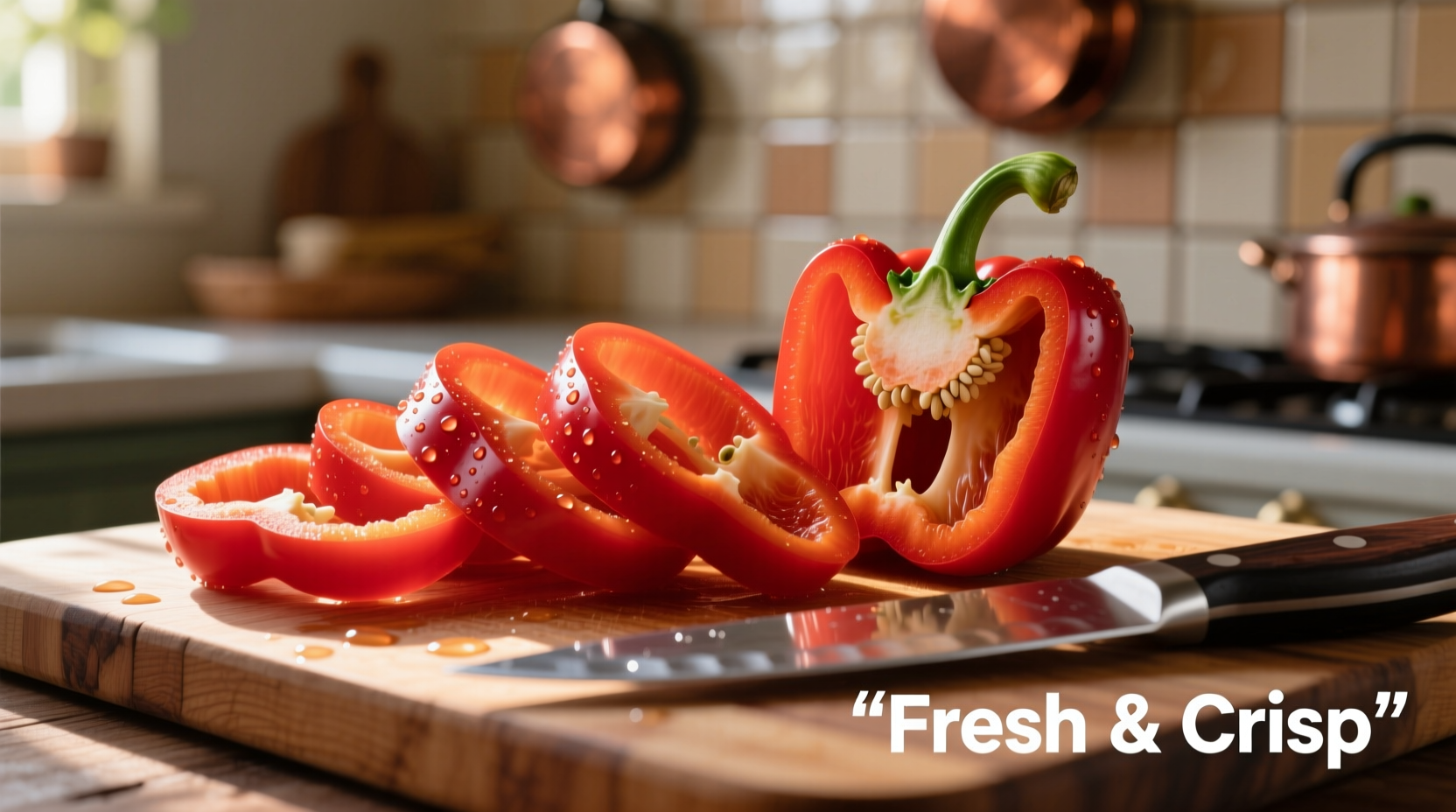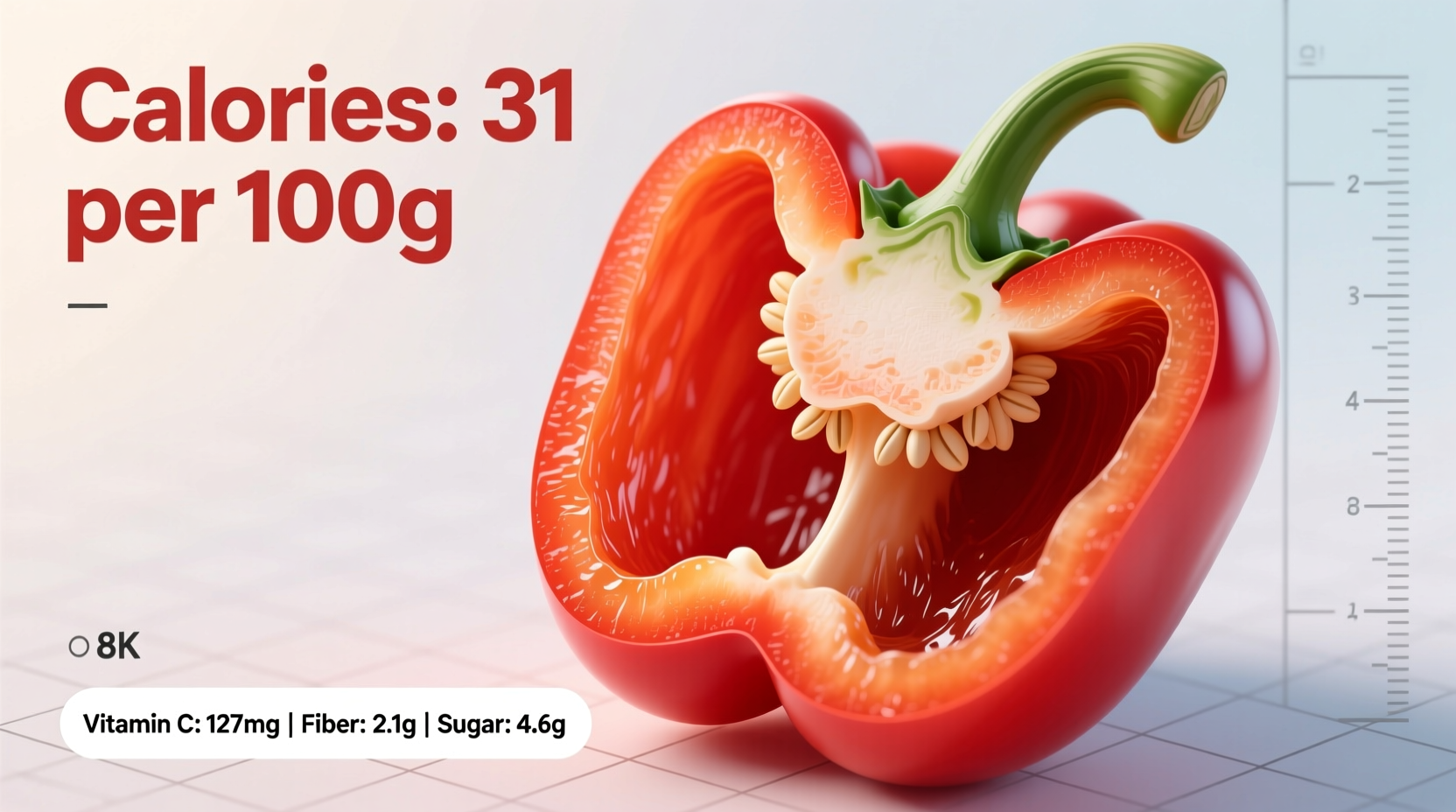Discover exactly how red bell peppers can enhance your nutrition plan without compromising your calorie goals. Whether you're tracking macros for weight management, building a balanced meal prep routine, or simply curious about this colorful vegetable's nutritional profile, you'll find precise, science-backed information to make informed dietary choices.
Nutritional Breakdown: What's Inside a Red Bell Pepper
Understanding the complete nutritional profile helps you maximize the health benefits of red bell peppers. Unlike their green counterparts, red bell peppers have fully ripened, developing higher nutrient concentrations while maintaining their remarkably low calorie count.
| Nutrient | Amount per Medium Pepper (119g) | % Daily Value |
|---|---|---|
| Calories | 37 | 2% |
| Total Fat | 0.3g | 0% |
| Carbohydrates | 9g | 3% |
| Dietary Fiber | 2.5g | 9% |
| Sugar | 5.4g | - |
| Protein | 1.2g | 2% |
| Vitamin C | 142mg | 158% |
| Vitamin A | 3131IU | 63% |
| Vitamin B6 | 0.3mg | 16% |
Data sourced from the USDA FoodData Central, the authoritative database for nutritional information in the United States. This comprehensive analysis shows why red bell peppers earn their reputation as nutritional powerhouses despite their minimal calorie contribution.
How Red Bell Peppers Compare to Other Varieties
Not all bell peppers deliver the same nutritional benefits. As bell peppers ripen from green to yellow to red, their nutrient profile significantly improves while maintaining similar calorie counts:
| Pepper Color | Calories (per 100g) | Vitamin C (mg) | Beta Carotene (mcg) |
|---|---|---|---|
| Green | 20 | 80 | 370 |
| Yellow | 31 | 132 | 950 |
| Red | 31 | 190 | 3100 |
According to research published by the Harvard T.H. Chan School of Public Health, the extended time red bell peppers spend ripening on the plant allows them to develop significantly higher concentrations of beneficial compounds compared to green varieties. This maturation process explains why red bell peppers contain nearly nine times more beta carotene than green peppers.
Practical Applications for Your Diet
Knowing the calorie content is just the beginning. Understanding how to incorporate red bell peppers into your daily eating pattern maximizes their nutritional benefits:
Perfect Portions for Common Goals
- Weight management: A whole medium red bell pepper adds only 37 calories while providing 2.5g of filling fiber
- Meal prep efficiency: Slice 2 peppers (238g) for 74 calories across multiple meals
- Post-workout nutrition: Pair with 2 tablespoons of hummus (70 calories) for a 110-calorie recovery snack

Preparation Methods and Calorie Impact
How you prepare red bell peppers affects their nutritional delivery, though not significantly their calorie count:
- Raw: Maximum vitamin C retention (158% DV) but slightly less bioavailable beta carotene
- Roasted: Increases antioxidant availability while maintaining the same 37-calorie base
- Stir-fried: Adds minimal calories when using 1 tsp healthy oil (40 calories)
The Mayo Clinic confirms that cooking methods don't substantially alter the calorie content of vegetables like bell peppers, though they can enhance the absorption of certain nutrients.
Beyond Calories: The Complete Health Picture
While the low calorie count makes red bell peppers ideal for various dietary approaches, their true value lies in their exceptional nutrient density:
Vitamin Powerhouse
That single medium red bell pepper delivers:
- 158% of your daily vitamin C needs - crucial for immune function and collagen production
- 63% of vitamin A as beta carotene - essential for vision and skin health
- 16% of vitamin B6 - important for metabolism and brain health
Antioxidant Richness
Red bell peppers contain multiple antioxidants including:
- Lycopene (the same compound in tomatoes) - associated with heart health
- Beta-carotene - converts to vitamin A in your body
- Capsanthin - gives red peppers their color and has anti-inflammatory properties
Common Misconceptions Clarified
Several myths persist about bell pepper nutrition that deserve clarification:
"Red bell peppers have more sugar, so they're less healthy"
While red bell peppers do contain slightly more natural sugars (5.4g vs 4.2g in green), this comes with dramatically higher nutrient concentrations. The additional sugar represents less than 2% of daily recommended limits for most adults and comes packaged with valuable fiber and nutrients.
"All bell peppers have identical nutrition"
Research from the National Institutes of Health shows significant nutritional differences between pepper colors. Red bell peppers contain up to 9x more beta carotene and 1.5x more vitamin C than green varieties due to their extended ripening period.
Maximizing Your Red Bell Pepper Experience
For optimal nutritional benefit and culinary enjoyment:
- Store whole peppers in the crisper drawer for up to 2 weeks
- Wash just before use to prevent premature spoilage
- Pair with healthy fats (like olive oil or avocado) to enhance absorption of fat-soluble vitamins
- Use raw in salads for maximum vitamin C or roasted for enhanced antioxidant availability
Remember that one medium red bell pepper (119g) provides exceptional nutrition for just 37 calories - an ideal addition to virtually any eating pattern. Whether you're following a Mediterranean diet, keto approach, or simply eating more plants, red bell peppers deliver outstanding nutritional value without compromising your calorie goals.











 浙公网安备
33010002000092号
浙公网安备
33010002000092号 浙B2-20120091-4
浙B2-20120091-4